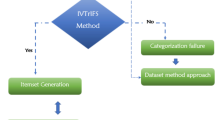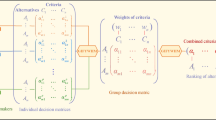Abstract
Fuzzy Data Envelopment Analysis is a modeling technique that efficiently ranks decision-making units (DMUs) based on imprecise inputs and outputs. The method constructs an efficient frontier line that separates efficient and inefficient DMUs. The goal is to improve the efficiency score of each inefficient DMU by moving them to the efficient frontier. In this study, we introduce a new approach, called the Pythagorean approach, which considers both the input and the output aspects. The approach is applied to the CCR model, and a new version of the BCC model is introduced, known as the Pythagorean approach-based BCC model. To handle the vagueness of the data set, the Pythagorean approach-based BCC model is extended to a fuzzy environment using a new type of fuzzy number called a sine-shaped fuzzy number. Finally, the efficacy of the model is tested in Indian public sector banks.





Similar content being viewed by others
References
Arya, A., & Singh, S. (2021). Development of two-stage parallel-series system with fuzzy data: A fuzzy dea approach. Soft Computing, 25(4), 3225–3245.
Arya, A., & Yadav, S. P. (2018). Development of fdea models to measure the performance efficiencies of dmus. International Journal of Fuzzy Systems, 20(1), 163–173.
Arya, A., & Yadav, S. P. (2017). A fuzzy dual sbm model with fuzzy weights: an application to the health sector. In: Proceedings of sixth international conference on soft computing for problem solving, pp. 230–238. Springer.
Banker, R. D., Charnes, A., & Cooper, W. W. (1998). Some models for estimating technical and scale inefficiencies in data envelopment analysis. Management science, 30(9), 1078–1092.
Bauer, P. W., Berger, A. N., Ferrier, G. D., & Humphrey, D. B. (1998). Consistency conditions for regulatory analysis of financial institutions: a comparison of frontier efficiency methods. Journal of Economics and business, 50(2), 85–114.
Cooper, W. W., Seiford, L. M., Tone, K., et al. (2007). Data envelopment analysis: A comprehensive text with models, applications, references and DEA-solver software (Vol. 2). New York: Springer.
e Costa, C. A. B., de Mello, J. C. C. S., & Meza, L. A. (2016). A new approach to the bi-dimensional representation of the dea efficient frontier with multiple inputs and outputs. European Journal of Operational Research, 255(1), 175–186.
Dotoli, M., Epicoco, N., & Falagario, M. (2015). Integrated supplier selection and order allocation under uncertainty in agile supply chains. In 2015 IEEE 20th Conference on Emerging Technologies andFactory Automation (ETFA), pp. 1–6. IEEE.
Emrouznejad, A., Tavana, M., & Hatami-Marbini, A. (2014). The state of the art in fuzzy data envelopment analysis. Performance measurement with fuzzy data envelopment analysis, pp. 1–45.
Fukuyama, H., Tsionas, M., & Tan, Y. (2022). Dynamic network data envelopment analysis with a sequential structure and behavioural-causal analysis: Application to the chinese banking industry. European Journal of Operational Research.
Hatami-Marbini, A., Emrouznejad, A., & Tavana, M. (2011). A taxonomy and review of the fuzzy data envelopment analysis literature: Two decades in the making. European journal of operational research, 214(3), 457–472.
Kao, C., & Liu, S.-T. (2000). Fuzzy efficiency measures in data envelopment analysis. Fuzzy sets and systems, 113(3), 427–437.
Kao, C., & Liu, S.-T. (2004). Predicting bank performance with financial forecasts: A case of taiwan commercial banks. Journal of Banking and Finance, 28(10), 2353–2368.
Khalili-Damghani, K., Tavana, M., & Santos-Arteaga, F. J. (2016). A comprehensive fuzzy dea model for emerging market assessment and selection decisions. Applied Soft Computing, 38, 676–702.
Klir, G., & Yuan, B. (1995). Fuzzy Sets and Fuzzy Logic (Vol. 4). New Jersey: Prentice Hall.
Mahmoudi, A., Javed, S. A., & Mardani, A. (2022). Gresilient supplier selection through fuzzy ordinal priority approach: decision-making in post-covid era. Operations Management Research, 15(1), 208–232.
Nasseri, S. H., Ebrahimnejad, A., & Gholami, O. (2018). Fuzzy stochastic data envelopment analysis with undesirable outputs and its application to banking industry. International Journal of Fuzzy Systems, 20(2), 534–548.
Peykani, P., Mohammadi, E., Pishvaee, M. S., Rostamy-Malkhalifeh, M., & Jabbarzadeh, A. (2018). A novel fuzzy data envelopment analysis based on robust possibilistic programming: possibility, necessity and credibility-based approaches. RAIRO-Operations Research, 52(4–5), 1445–1463.
Puri, J., & Yadav, S. P. (2013). Performance evaluation of public and private sector banks in india using dea approach. International Journal of Operational Research, 18(1), 91–121.
Puri, J., & Yadav, S. P. (2014). A fuzzy dea model with undesirable fuzzy outputs and its application to the banking sector in india. Expert systems with applications, 41(14), 6419–6432.
Puri, J., & Yadav, S. P. (2017). Improved dea models in the presence of undesirable outputs and imprecise data: an application to banking industry in india. International Journal of System Assurance Engineering and Management, 8(2), 1608–1629.
Royden, H. L., & Fitzpatrick, P. (1988). Real Analysis (Vol. 32). New York: Macmillan.
Sahil, M. A., Kaushal, M., & Lohani, Q. D. (2020). A parabolic based fuzzy data envelopment analysis model with an application. In: 2020 IEEE International Conference on Fuzzy Systems (FUZZ-IEEE), pp. 1–8. IEEE.
Tlig, H., & Hamed, A. B. (2017). Assessing the efficiency of commercial tunisian banks using fuzzy data envelopment analysis. Journal of Data Envelopment Analysis and Decision Science, 2, 14–27.
Wang, Y.-M., Luo, Y., & Liang, L. (2009). Fuzzy data envelopment analysis based upon fuzzy arithmetic with an application to performance assessment of manufacturing enterprises, 36(3), 5205–5211.
Zimmermann, H.-J. (2011). Fuzzy Set Theory–and Its Applications. New York: Springer.
Funding
The authors have not disclosed any funding.
Author information
Authors and Affiliations
Corresponding author
Ethics declarations
Conflict of interest
On behalf of all authors, the corresponding author states that there is no conflict of interest.
Ethical Approval
The author of this article did not conduct any research involving human subjects or animals. This article is based on existing literature and data from other sources.
Additional information
Publisher's Note
Springer Nature remains neutral with regard to jurisdictional claims in published maps and institutional affiliations.
Rights and permissions
Springer Nature or its licensor (e.g. a society or other partner) holds exclusive rights to this article under a publishing agreement with the author(s) or other rightsholder(s); author self-archiving of the accepted manuscript version of this article is solely governed by the terms of such publishing agreement and applicable law.
About this article
Cite this article
Sahil, M.A., Kaushal, M. & Lohani, Q.M.D. A Novel Pythagorean Approach Based Sine-Shaped Fuzzy Data Envelopment Analysis Model: An Assessment of Indian Public Sector Banks. Comput Econ (2024). https://doi.org/10.1007/s10614-024-10603-7
Accepted:
Published:
DOI: https://doi.org/10.1007/s10614-024-10603-7




